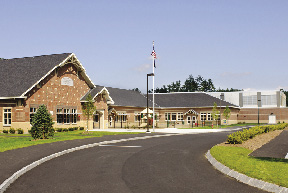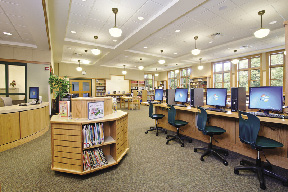After years of planning, design and construction, the Idlehurst Elementary School welcomed 580 pre-K-5 students to their first week of classes in late August. Students are now being educated in the "greenest" school in the state, according to Ed Murdough of the N.H. Department of Education.
Designed by A/E firm Harriman, the 82,000 s/f school includes 24 classrooms, two speech and language rooms, a media center with computer lab, gymnasium, music and art rooms, and a cafetorium with a stage for performances. Parts of the $19.9 million school can be used as a community-wide resource, with the gymnasium, cafetorium, library and dedicated community room in a separate zone. Also, in the event of a disaster, the facility is designated a community shelter.
According to Anthony Roy, Harriman's project manager, "many energy-saving measures are incorporated. An example is orienting the school so that all classrooms are flooded with natural light. In addition, we used sunshades on the south-facing façade to limit direct sunlight into spaces, reducing cooling costs and increasing student comfort."
Energy-efficient measures. In addition to the sunshades and building orientation, additional measures were designed into the school. Preliminary projections are that these measures will result in 1,454,000 KBtu/yr. total building energy reduction and a nearly 30% economic cost improvement over the code minimum that meets the ASHRAE 90.1-2007 building energy standard. Some of these measures include:
* displacement ventilation. Displacement ventilation is used as an extremely effective method for introducing and distributing air low in a room near the floor. As the air rises, it is heated by the radiant floor and by occupants' body temperatures, and then returned in a centrally located ceiling diffuser. Because of the lower air volumes, air handlers can be sized 25% smaller.
* radiant floor heating. 100% of the classrooms incorporate radiant floor heating, which is a perfect companion to the low-water-temperature heating system.
* demand ventilation and CO2 control. Demand ventilation provides air into a space only if it is occupied and is controlled by an occupancy sensor. In unoccupied spaces the air-handling unit is slowed down, conserving energy. The use of CO2 control in ventilation systems allows only the quantity of air into a space to satisfy ventilation requirements for the number of people in the room. If the CO2 sensor detects very few people in a room, then only a minimum level is brought in. These methods of controlling the amount of air introduced produces significant energy savings.
* daylighting/continuous dimming control. Daylighting control strategies include the use of internal light shelves, external sunshades, and automatic control of the electrical lighting in a space. Sunlight entering through windows and reflected off a light shelf allows powered lighting levels to be automatically turned off, while maintaining proper lighting foot-candles to adequately light the space. The combination of light shelves, sunshades, and automatic-dimming controls can provide significant electrical savings.
* variable frequency drives (VFD's). VFD's are used on all air-handling unit supply and return fans. There is no need for HVAC fans to always operate at 100% power, and there are significant savings in reducing the power to meet actual demand.
* variable-volume kitchen exhaust. The variable-volume exhaust control system in the school's kitchen varies the amount of exhaust airflow depending on the temperature of exhaust air and the amount of smoke.
The payback on many of the measures above range from two years to five years, resulting in significant savings over the life of the project.
"There are numerous HVAC systems, energy-saving tactics, and lighting options available today that have a significant impact on school efficiencies," said Anthony Roy. "With the support of the client and the state, many of these were incorporated into the school."
As an incentive and reward for energy efficiency and sustainable measures, the school has received $75,000 from Public Service of N.H. and is expecting to receive $400,000 from the Collaborative for High Performance Schools. The project received 35% of its funding from the state and the remainder was locally funded.
The project team included: Bonnette, Page & Stone Corp., construction manager; Harriman, architects & engineers; Keeley Painting Co., painting; Turcotte's Concrete Floors, Inc., latwork; Eckhardt & Johnson, Inc., plumbing & hvac; and Hampshire Fire Protection, fire protection.
.png)









